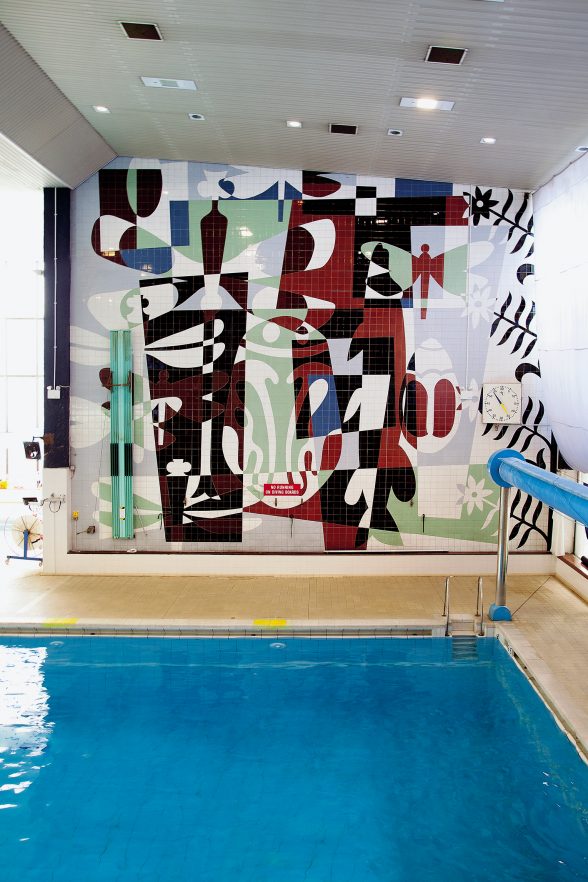This website uses cookies
This website uses cookies to enable it to function properly and to analyse how the website is used. Please click 'Close' to accept and continue using the website.



The Twentieth Century Society is calling for a review of listing policy for post war buildings following the decision to turn down a listing application for Halifax Swimming Pool and its two distinctive internal murals.
The C20 Society’s Senior Caseworker Grace Etherington said: “We are naturally disappointed that our listing application was turned down. In most cases we accept the decisions made by Historic England’s listing teams, although we do not always agree with their conclusions. This case is an exception as we feel that the building deserves a more thorough assessment, as the reasons for refusal are inadequate and unconvincing. The murals in particular have been dismissed without any explanation, which is not acceptable for an artwork of this size and intricacy. As a prominent piece by an artist mentioned in Historic England’s guidance on post-war public art, and as the subject of a photograph in the Pevsner Architectural Guide for Yorkshire’s West Riding, we expect more than an unsubstantiated dismissal.”
“We have reached the point where more than just the crème de la crème of post-war buildings should be awarded listed status, as lots of smaller scale contextual buildings, often designed by local authorities’ in-house architecture departments, have been overlooked. It is the norm for good quality but not outstanding buildings from earlier dates to be listed at Grade II, and we feel that listing policy should to be updated to include a similar standard of post-war buildings. If things continue as they are for much longer, future generations will not be able to access a representative range of architecture from the past 70 years.”
C20 is preparing a request to the Department for Digital, Culture, Media and Sport (DCMS) for the listing decision to be reviewed.
In its listing assessment, HE states:
Calderdale Council has committed funds to build a new sports and leisure centre in Halifax, which will contain a new swimming pool. Demolition of the old pool was being suggested so the site could be sold for redevelopment or used for car parking, however we now know that the Council are exploring a range of options for the building’s future. We have been contacted by the Chief Executive of Calderdale Council who has expressed admiration for the building and reassured us that the future of the murals is being treated as a priority. It had been hoped that listed status would be a helpful tool to guide decision making about the building’s future, so it is great to hear that the local authority are independently considering more sustainable and conservation-friendly options. Experience tells us that the story would not be the same for many other local authorities across the country.
Designed by F H Hoyles, the Deputy Borough Architect, under the supervision of the Borough Architect J L Berbiers, and constructed in the 1960s, Halifax Swimming Pool is an admirable effort by the local authority to translate local distinctiveness into modern design. The building succeeds in its aim to draw in local people but not overwhelm the historic character of its surroundings.
It strikes an interesting balance between modern and contextual design. It has clean lines and blocky forms, and the way that the internal spaces are grouped and expressed externally, neatly stepping down the sloping site, works with the variety of facade textures in local materials to add interest to the elevations. These design features create a well composed and thoughtful building that otherwise may have been a mismatched or bulky addition to the area’s predominantly historic grain.
The interior of the swimming pool features two ceramic murals by artist Kenneth Barden (1924-1988), depicting British pond life. The mural is a collage of different plants and insects, layered in a geometric motif with vibrant blues, reds, purples and greens. The aquatic theme ties in with the building’s function and creates a lively backdrop to the diving pool.
Barden designed a number of ceramic murals in the post-war period, with notable examples being the massive Carter tile facade panels for the Harbour and Seaward residential towers in Gosport (1961-68), and an interior mural depicting historic pump mechanisms at a Pump House in Sawbridgeworth for the Hertfordshire and Essex Water Board (1955).
Berbiers was the Chief Architect in Canterbury in the immediate post-war years, where he gained extensive experience in modernising historic urban areas. His reverence for the historic environment is shown through numerous published collections of his drawings of old and threatened buildings.

Become a C20 member today and help save our modern design heritage.